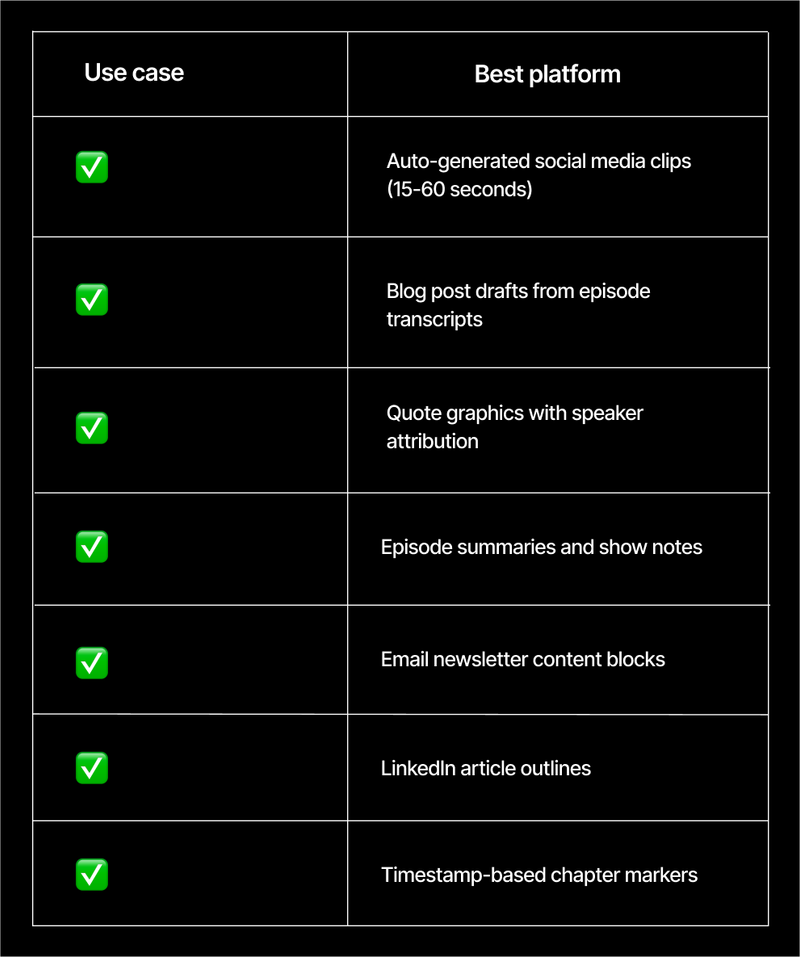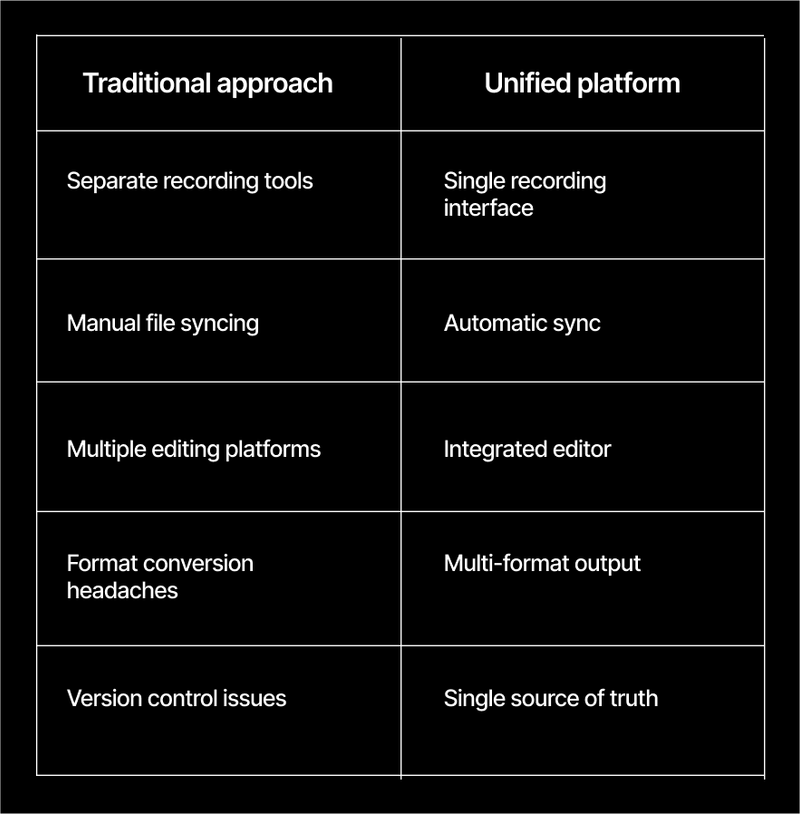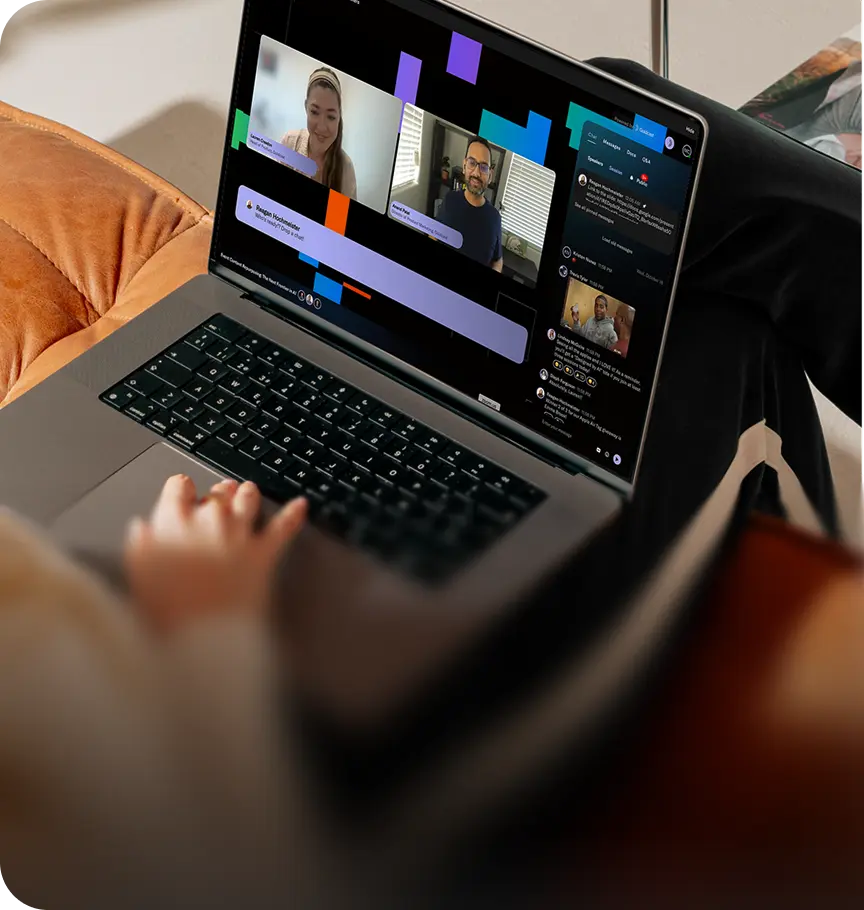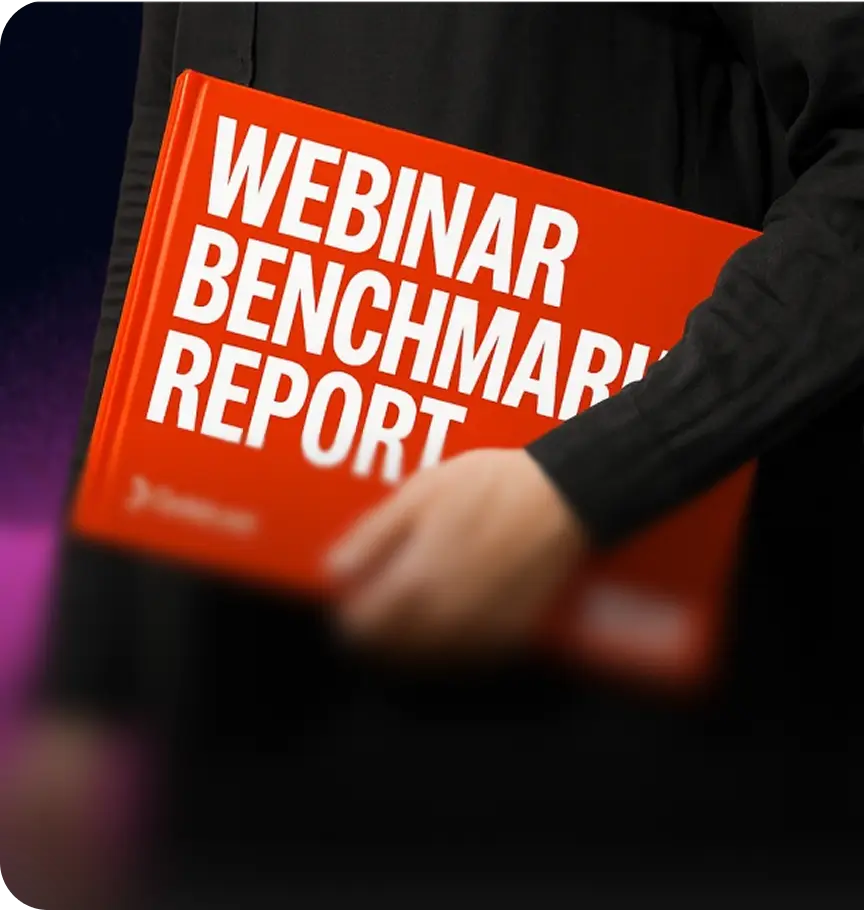How to Edit a Podcast: A Modern Guide for B2B Marketers

Table of Contents
- The B2B podcast editing process has evolved beyond audio clean-up
- Phase 1: Pre-production and recording for a flawless edit
- Phase 2: How to edit your podcast, step by step
- Phase 3: Podcast editing for a multi-channel world
- Setting up a modern podcasting workflow that works for B2B
- Elevate your podcast editing with Goldcast
Maximize Your Marketing ROI
Join 10,000 other marketers already getting the best tips on running engaging events that boost pipeline and create raving fans.
Most marketers still think podcast editing means cleaning up audio mistakes and balancing sound levels. But there's a much bigger opportunity sitting in your recordings.
Editing isn't just about fixing problems anymore. It's about shaping narratives, maximizing engagement, and creating multichannel content that grows mindshare.
This guide will show you exactly how to turn podcast editing from a technical task into a strategic advantage for B2B marketers.
The B2B podcast editing process has evolved beyond audio clean-up
Think of podcast editing as building a story that captivates your audience from start to finish. By strategically structuring your content—using hooks, narrative arcs, and thematic segments—you can keep listeners coming back for more.
“We're really hungry for authentic human connection,” says Rachel Elsts Downey, Founder and CEO of Share Your Genius, “and the number one way to connect somebody with somebody is through conversation. Podcasting specifically is the channel to do that in a very authentic way.”
Want to know our secret weapon for keeping content sharp? We call it the "listener benefit test."
It's simple: Every moment of your podcast should deliver clear value to your audience. That means cutting the fluff—tangential discussions, repeated points, awkward pauses—and keeping only what matters to listeners. This approach transforms casual conversations into compelling thought leadership. ✨
And the best part is, your podcast recording is just the beginning. One 45-minute podcast episode can become:
- 10 social media clips
- 3 blog posts
- A series of LinkedIn articles
- Email newsletter content
- Infographic data points
- And more
Instead of creating a single episode and moving on (what a waste!), successful B2B podcasters treat their recordings as source material for a much bigger content ecosystem.
Because with 200,000 new podcasts launched in 2024 alone, you need more than good content to stand out. You need a smart editing strategy that squeezes maximum value from every episode.
Phase 1: Pre-production and recording for a flawless edit
Want a smooth and painless editing process? Start with amazing source material. Let's walk through how to capture pristine audio from the start—because even the best editing tools can't fix a rough recording.
Record isolated tracks
Isolated tracks
Non-negotiable tip: When recording your podcast, give every speaker their own mic and recording track. Why? Because separate tracks let you fix audio issues for each person individually. Need to boost someone's volume? Remove background noise? Replace a flubbed sentence? No problem—you can do it all without affecting the other speakers.
Local recording
When platforms record locally, internet glitches don't mess with raw files. No more "Sorry, you're breaking up!" moments ruining your final edit. Each speaker's audio and video gets captured in full HD quality. 🙌
Create a professional experience for podcast hosts and guests
A seamless backstage experience translates to better raw recordings. When your speakers feel comfortable and confident, you'll capture naturally engaging conversations—and spend less time editing.
Features that make guests feel like pros:
- Countdown timers (no more awkward “are we rolling?” moments)
- Easy slide uploads (tech hiccups = confidence killers)
- Dedicated producer controls (someone managing the tech behind the scenes)
The investment you make in creating a polished recording pays dividends during editing. You'll spend less time fixing technical issues, and more time creating high-impact content.
Audacity, Descript, and GarageBand, oh my!
We dig into the details of the tools you do (and don’t!) need in our guide to
Phase 2: How to edit your podcast, step by step
Ready to transform your raw recording into a polished podcast? We'll break down our streamlined editing process into clear, manageable steps—no audio engineering degree required.
Rough cut with text-based editing
Traditional editing means hunting through podcast audio waveforms to find the right moments to cut. It's time-consuming and requires technical expertise most B2B marketers don't have (and shouldn’t need).
Enter text-based editing—your new best friend. Instead of working with waveforms, you edit by simply deleting and moving words from an auto-generated transcript, making it super easy to spot and remove meandering tangents or redundant segments that don't add value for your listeners. ✂️
If you can edit a Google Doc, you can edit a podcast. It really is that simple. (We have tutorials, but you won’t need them.)
Automated cleanup and enhancement
Manual editing used to eat up your entire day—we're talking 3-5 hours of work for every hour recorded. But AI-powered tools have changed the game. With just one click, they handle the tedious cleanup while keeping conversations natural and engaging.
Common AI-powered cleanup features that'll save your sanity:
- Automatic filler word removal (um, ah, like)
- Background noise reduction
- Audio level equalization between speakers
- Dead air and long pause trimming
- Echo and reverb correction
The right AI knows which pauses add dramatic effect and which ones just make listeners reach for the skip button. The result? Polished audio that keeps your audience hooked.
Polishing with branding and production elements
Intros, outros, background music and sound effects can transform a simple recording into a professional podcast production. But consistency is everything. Your brand elements should be standardized across all episodes to build recognition and authority.
If you're creating video podcasts (and you should be!), make sure your platform makes it easy to add custom backgrounds, lower-thirds, and overlays. These visual touches aren't just nice-to-haves—they're essential for professional B2B content.
With the right podcast editing platform, you can create broadcast-quality content without breaking your budget. 🎬
Final mix and master for distribution
One last technical detail before you hit publish: Check those audio levels! Most podcast platforms want your audio at -16 LUFS (fancy talk for consistent volume). Why does this matter? Because you want your podcast to sound great whether someone's listening through AirPods at the gym or blasting it in their car.
Phase 3: Podcast editing for a multi-channel world
Think your work is done once the episode is edited? Think again! Smart B2B marketers know the real magic happens when you turn that recording into a content multiplication machine. 🚀
From episode production to content multiplication
The “one-and-done” approach to podcast content is dead and buried. Why spend hours manually hunting for shareable moments after the fact?
Instead, you can build content multiplication right into your editing workflow and watch your content library grow. It's not about randomly spreading content everywhere—it's about strategic repurposing from day one.
Content formats to extract during editing:
- Customer story snippets for case studies
- Framework explanations for infographics
- Compelling debates for LinkedIn discussion posts
- Expert quotes for social media graphics
- Educational segments for blog post content
- Behind-the-scenes moments for culture content
Think strategically about formats during editing: That compelling customer story could become a case study snippet. The framework your guest shared could become an infographic. The debate between panelists could be perfect for sparking discussion on LinkedIn.
Using AI to instantly repurpose your podcast
AI-powered content repurposing tools automatically spot share-worthy moments, turning them into ready-to-use content in minutes.
Want social clips perfectly sized for each platform? Blog posts ready for a quick edit? Promo copy that actually sounds like your brand? AI handles it all, straight from your podcast recording. No video editing expertise needed. ✨
As a major bonus, the right repurposing workflow also puts you a step ahead of the competition.
The Content Marketing Institute reports that B2B marketers expected to increase investments in 2025 in video (61%), AI for content creation (39%), and audio content (20%).

Unifying video and audio workflows
Video isn't just a nice-to-have anymore—46% of podcast listeners want to see your face while they listen. But juggling separate video and audio files? That's a headache no marketer needs.
That's where an all-in-one platform becomes your best friend. Record, edit, and repurpose both video and audio in one place, so you can focus on what matters: creating content your audience loves.

When you need to deliver content across multiple channels—from audio-only podcast feeds to social video snippets—having everything in one place just makes sense.
Setting up a modern podcasting workflow that works for B2B
As a B2B marketer, you're probably working with limited time, a lean team, and high expectations for quality. The solution? A streamlined workflow that lets you create professional content without the stress.
Integrating your podcasting workflow
Jumping between different tools for recording, editing, and repurposing is a recipe for version control nightmares and missed deadlines.
The smarter play? Bring everything into one streamlined environment. When your team can access the same platform and files, feedback travels faster and you can focus on what you do best: creating amazing content that drives results.
Plus, when your whole team works in the same platform, feedback flows faster and everyone stays in sync. No more endless email chains about file versions!
From single-purpose tools to an all-in-one platform
Still working with a patchwork of tools? Between podcast editing software, transcription services, and creating video clips, it’s a lot. And as your podcast grows, that patchwork approach will seriously slow you down.
Modern platforms combine recording, editing, AI-powered repurposing, and branded publishing in one place—exactly what you need to create high-impact content efficiently.
Benefits of an integrated workflow:
- Time savings: Eliminate file transfers between platforms
- Quality control: Consistent processing across all content
- Version management: Single source for all assets
- Team collaboration: Shared access and real-time updates
- Brand consistency: Standardized templates and styling
- Analytics integration: Unified performance tracking
B2B marketing tools have evolved to match how we actually work. So don't waste your time getting caught up in professional audio software just because it sounds impressive.
Instead, think intuitive interfaces, quick learning curves, and features that make sense for content creation in a fast-paced B2B environment.
Elevate your podcast editing with Goldcast
Ready to transform your podcast workflow? We built Recording Studio specifically for B2B marketers like you.
Our platform captures pristine audio and video on separate tracks, giving you total control over your content. No technical expertise needed—just professional-quality recordings every time.
What makes Goldcast different:
🎙️ Recording Studio: Locally-recorded, multi-track audio/video for amazing quality
✂️ Text-based editing: Edit as easily as a Google Doc—no technical skills required
🤖 AI Content Lab: Turn one recording into dozens of clips, blogs, and social posts in minutes
🎨 Brand consistency: Custom backgrounds, overlays, and templates across all content
Spend less time wrestling with tech and more time creating content that drives results.
Ready to transform your podcast editing workflow? Book a demo of Goldcast Recording Studio or try Content Lab free today.
Transform Your Video Marketing with AI
Stay In Touch
Platform
Resources
© 2025 Copyright Goldcast, Inc. All rights reserved.





 Upcoming Events
Upcoming Events Event Series
Event Series On-Demand Events
On-Demand Events

